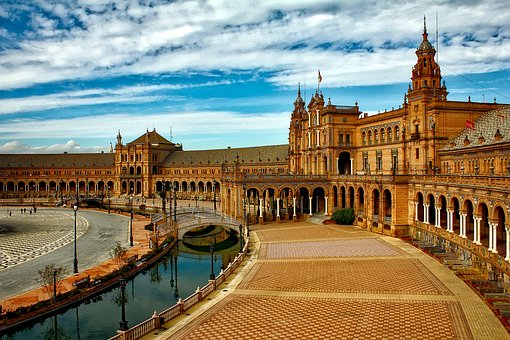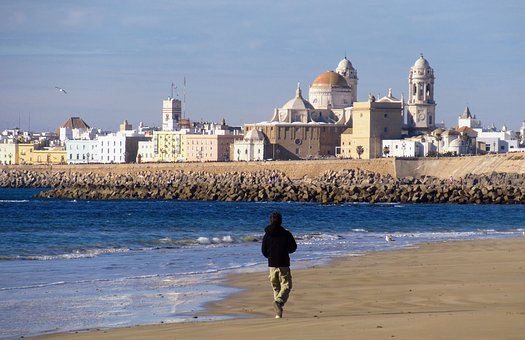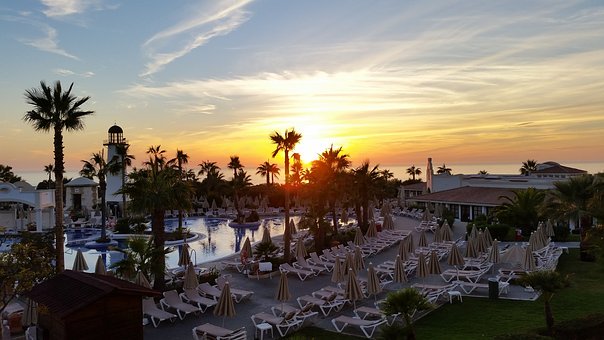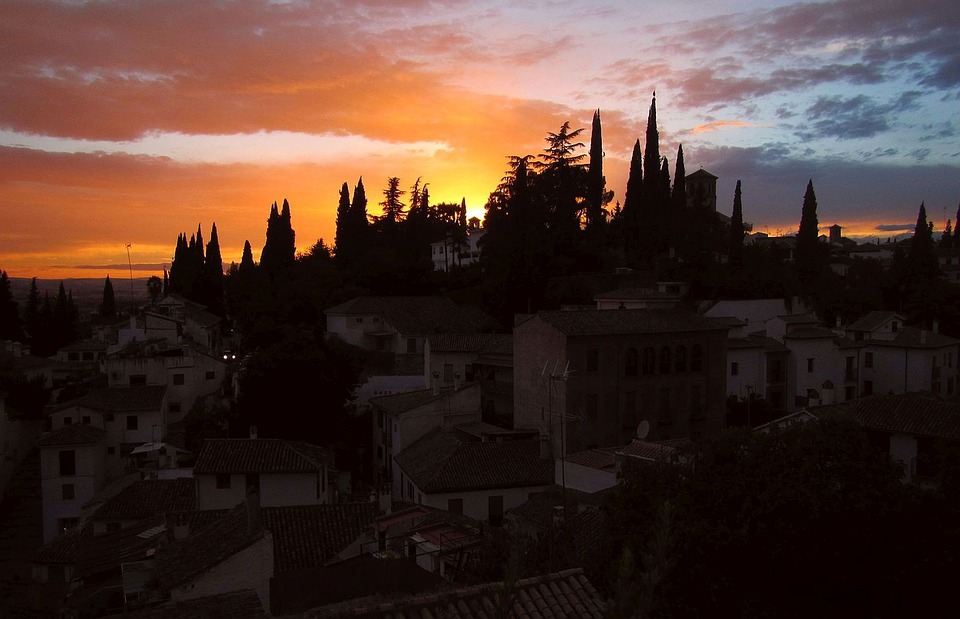Andalucia - Gateway to the
Americas by Mark Buckingham
|

View map of Andalucia
|
Andalucia is the most populated
and second largest of the seventeen autonomous communities that constitute
Spain. Its capital is Seville and it is bordered on the north by Extremadura
and Castilla-La Mancha; on the east by Murcia and the Mediterranean Sea
and on the west by Portugal and the Atlantic Ocean.

The British colony of Gibraltar
at the south shares its three-quarter-mile land border with the Andalusian
province of Cádiz.
Its varied landscapes, the
stability of its climate with 3000 hours of sun per year and the friendly
character of its population, have turned it into one of the most attractive
and most visited regions.
Coastlines of fine sandy
beaches characterize the provinces of Huelva and Cadiz, which face the
Atlantic Ocean. The Mediterranean coast, from the Strait of Gibraltar to
Almeria, on the other hand has a smoother climate with less wind and higher
water temperatures.
Visitors to the region are
spoiled for choice. From the golden beaches to those beautiful mountain
ranges, and the famous "white villages", the possibilities are endless.
Sports lovers are well catered for here and anything from skiing in the
Sierra Nevada to surfing at the coast of Cadiz can easily be found.
In Andalucia you will live
the magic of Flamenco and bullfighting in their most authentic style, and
myths like Don Juan and Carmen were born here. This is a land of great
traditions, which has understood how to incorporate progress.
The Spanish spoken in the
Americas is largely descended from the Andalusian dialect of Spanish due
to the role played by Seville as the gateway to Spain's American territories
in the 16th and 17th centuries.
Major Attractions in Andalucia
Seville:
The Andalusian capital, the third largest city of Spain, is among the most
beloved places by tourists, thanks to its unique ambience and its great
monuments. The Arabian bell tower Giralda, the city's landmark, the enormous
cathedral, Torre del Oro and the old district Barrio Santa Cruz are among
the highlights.
Granada:
The Moorish Jewel, located at the foot of snowy Sierra Nevada mountain
range, is a must-see. Most outstanding is certainly the great Arabian palace
Alhambra.

Cordoba:
The long-time centre of Moorish Spain, Cordboa has monuments of outstanding
importance. The Mezquita, the great Mosque, is perhaps, most impressive.
Malaga:
Among its major attractions are the Moorish Alcazaba and the splendid Mediterranean
coast. Málaga is also well known as being the birthplace of Pablo
Picasso, the painter and sculptor.
Costa
del Sol: The coast of Malaga is home to some of Spain's most impressive
beaches. Among the most famous are in the towns of Marbella,
Torremolinos,
Benalmadena,
Fuengirola
and San Pedro de Alcantara.
Ronda:
In the middle of the bizarre mountain range Serranía de Ronda, at
the edge of a canyon of a depth of 120 metres, you will find Ronda - certainly
one of the most incredible and beautiful towns in Spain.
Almeria:
Almeria is among those Andalusian cities that have best preserved their
Moorish heritage. The Costa de Almeria is also an area of great tourist
attractions.
Cadiz:
Cadiz is one of the oldest cities in Spain. It is fascinating for its typical
Andalusian ambience with whitewashed houses and tropical vegetation. Compared
with the spectacular nature of other carnival celebrations, the light-hearted
fun and entertainment of the Carnival of Cadiz makes it a unique fiesta
which is well worth getting to know.

Huelva: Huelva is
of great importance as a fishing port as well as for its industry. Christopher
Columbus, who started his travel to America from the nearby Palos de la
Frontera, marks the city and its surroundings. There you may still visit
the monastery where he prepared his travel, alongside with a reconstruction
of the port and the three famous ships.
Doñana National
Park: This extensive preserve including beach areas with moving dunes
as well as marshy regions of great value concerning their fauna is located
next to the outlet of Guadalquivir River, Matalascañas, Acebuche
and El Rocio. Numerous species of migrant birds, on their way from Eurasia
to Africa, stay here during the breeding phase.
Costa de la Luz: The
"Coast of the Light", in the provinces of Huelva and Cadiz at the Atlantic
Ocean, offers splendid beaches of fine sand. Major centres of attraction
are Punta Umbria, Islantilla, Isla Cristina, Mazagon, Matalascañas,
Barbate, Algeciras, Tarifa, Conil de la Frontera, Chiclana de la Frontera,
El Puerto de Santa Maria, Rota, Chipiona and Sanlucar de Barrameda.
Jerez de la Frontera:
In the hometown of the world-famous Sherry wine several "Bodegas" may be
visited. Jerez is the site of a renowned equestrian school. Wine and horses
mark the ambience of this manorial town

Jaen: Its medieval
fortress dominates Jaen, which is located inland. Additional attractions
are the 11th century Moorish baths and the Renaissance cathedral. The nearby
Sierra de Cazorla is an outstanding nature reserve.
Andalusian Cuisine
Andalucían cuisine
is characterized by gazpacho, fried fish, the jamones of Jabugo and Trevélez
and the wines of Jerez, particularly sherry.
Fried Foods: Frying
in Andalusian cuisine is dominated by the use of an olive oil that is produced
in the provinces of Jaén, Córdoba, Seville and Granada. The
foods are dredged in flour 'a la andaluza' (meaning only flour, without
egg or other ingredients). They are then fried in a large quantity of hot
olive oil.
Fish and Shellfish:
With five coastal provinces, the consumption of fish and shellfish is rather
high: white shrimp from the Bay of Cádiz; prawns; murex; anchovies;
baby squid; cuttlefish, flounder, etc.
Desserts: Andalusian
deserts are heavily influenced by medieval Andalusian cuisine. Notable
dishes include pestiños (a deep-fried pastry bathed in honey), alfajores,
amarguillos (a form of almond macaroons) from Medina Sidonia, the polvorónes
(almond cookies of Estepa), lard bread, wine doughnuts, churro (a fried-dough
pastry-based snack) and torrijas.

Music of Andalusia
Andalusia is best known for
flamenco, a form of music and dance that is mostly performed by Gypsy people
and popular throughout the world.
Improvised flamenco songs
of ancient Andalusian origin are called Cante Hondo and are characterized
by a reduced tonal ambiance, a lack of rhythm and repetition of notes.
A single singer performs Cante Hondo songs.
Top
About the Author: Written
by Mark Buckingham, Managing Director of Rentaccomspain.com, an online
resource where you can find a wealth of Spanish property for rent and for
sale. |



